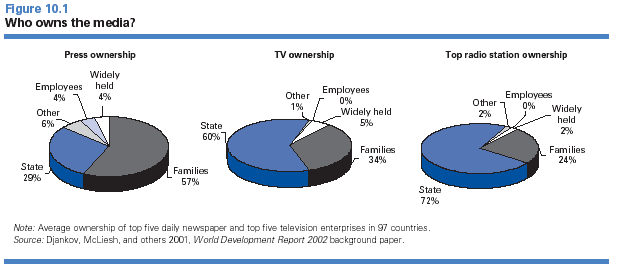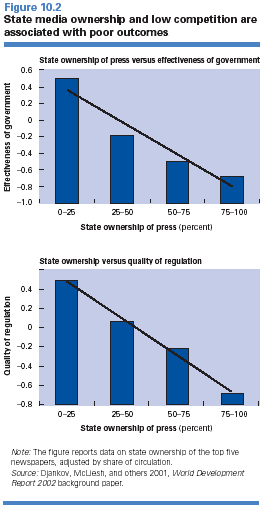
Useful Charts and Graphs from the WDR 2002
| Who Owns the Media? State media ownership and low competition associated with poor outcomes | |
 | |
 |
Ownership
structures around the world. A project for this Report gathered new
evidence on the ownership structures of the largest five newspapers and
five television stations in each of 97 countries (box 10.3).8 It found
state ownership to be pervasive (figure 10.1). On average, the state
controls about 30 percent of the top five newspapers and 60 percent of the
top five television stations in these countries. The state also owns a
huge share—72 percent—of the largest radio stations. Moreover, private
ownership is mostly in family hands rather than in widely dispersed
shareholdings. Some privately held media are also closely related to the
state, through business, family, and personal associations. So, the
influence of state control is even greater. State ownership also varies
significantly by region. On average governments in African and Middle
Eastern countries are more likely to own media outlets, but media outlets
in North and South America are owned almost exclusively by families.
Although most countries in the sample permit foreign ownership of the
media, only 10 percent of the top five newspapers and 14 percent of the
top five television stations are controlled by foreigners.
Monopolies mean worse outcomes. The evidence indicates that monopoly control over information or high levels of state ownership reduce the effectiveness of the media in providing checks and balances on public sector behavior. Analysis of the 97 countries in the same study established that media in countries with high levels of state ownership are much less free, measured by the media freedom indexes; they also transmit much less information to people in economic and political markets. In addition, state ownership of the media is found to be negatively correlated with economic, political, and social outcomes. Generally speaking, this translates into more corruption, inferior economic governance, less-developed financial markets, fewer political rights for citizens, and poorer social outcomes in education and health (figure 10.2). - WDR 2002, pages 184-185 |